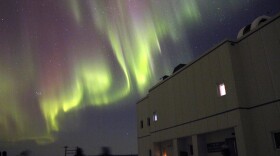If you've ever seen the Northern Lights, you've seen the most visible evidence of a solar storm. Bursts of electrically charged particles race toward Earth, and when they hit the planet's magnetic field, they cause beautiful auroras. A norm in northern locales, sky watchers in southerly states like Colorado were treated to a rare light show in June. In addition to clogging up your Instagram with photos, solar storms can also wreak havoc on our electric grid.
Federal regulators are working on new rules that are supposed to protect the electric grid from solar storms, but there's criticism that they don't go far enough.
Part of what makes solar storms so scary to people who work on the grid is their unpredictability. At the National Oceanic and Atmospheric Administration's Space Weather Prediction Center in Boulder, Colorado, teams of forecasters work around the clock trying to forecast them. They sit in a dark room, hunched in front of one of 10 or so computer screens, each with a different image of the sun. They look for sun spots, which are the source of solar flares, the origin of storms. When they spot one, they have to wait 15 hours or more to know how bad it is; that is about when the storm's charged particles reach a satellite about a million miles from earth that chief forecaster Bob Rutledge compared to "a hurricane buoy 50 miles off the coast of Miami."
All along, forecasters are sending out alerts about the storm to utilities, grid operators and federal agencies like the Federal Emergency Management Agency. Western Area Power Administration, which operates transmission lines and sells electricity to utilities in the western United States, is one of many power companies receiving those alerts.
Bill Timmons, a maintenance engineer for WAPA, said when his grid operators get the alert from Boulder, they pull out their solar storm operating procedures, which they are now required to have under federal rules. What they do next depends on the intensity of the storm.
"It's the same thing as a watch, warning or an alert, like a hurricane or tornado," he said.
During moderate and extreme storms, grid operators will monitor voltages and prepare to do "load shedding," or cutting power to certain parts of the grid to keep them from being damaged by solar storm-induced electric currents. Transformers, which step up and step down electricity voltages, are especially vulnerable in solar storms.
In decades of solar storm activity, Timmons said WAPA has never documented damage to the grid, and has never had to purposely cut power to protect transformers.
The modern grid hasn't yet experienced a truly massive solar storm like the so-called Carrington Event in 1859. Storm-induced electric current shocked telegraph operators, even lighting their papers on fire. If something like that were to happen in our much more electrified modern society, researchers say enough transformers could be damaged to cause 130 million Americans to lose power. Because transformers are so expensive and slow to build, the power could be out for months or even years.
For grid watchdog George Baker, "that's just an unacceptable outcome." An emeritus professor of applied science at James Madison University, Baker worked on an early study [.pdf] of a 1989 solar storm-caused blackout in Quebec. He believes if we're serious about protecting the grid, "really the only low risk way to do it is to install blocking devices."
These are devices that provide physical protection for transformers from electric currents. Baker and many others say they would work much better than the solar storm operating procedures utilities are currently required to have. Yet there's only one installed in the U.S., in Wisconsin. Under new regulations proposed by the Federal Energy Regulatory Committee, they won't be required for most U.S. power companies.
Bill Timmons, the engineer for WAPA, said blocking devices may be necessary, but he's not convinced.
"I think operationally we can manage this risk," he said. "I would hate to overreact to something that may not impact our grid."
But there is a fine line between overreacting and preventing the failure of our most important piece of infrastructure.
"When we lose our power grid in a large geographic area, we lose our capability to communicate, we lose potable water supply, we lose wastewater treatment supply and we lose our ability to pump and transport fuels," said Scott McBride, infrastructure security manager at Idaho National Laboratory who studies grid security. "The socioeconomic impacts cascade and it becomes very devastating."
Learning about solar storms, it's understandable why some people spend all their time stockpiling food, fuel and medicine. But grid watchdog George Baker said there are better ways to prepare.
"If we were to put our energies, rather, into lobbying our representatives to protect the grid, I think that's a much better solution," he said.
In the meantime, several states, including Arizona, Maine, New Jersey, New York and Virginia, have passed or are weighing laws to protect their power grids from solar storms and electromagnetic pulses, [.pdf] which can have a similar impact. The Department of Energy is concerned enough that it is considering a plan to stockpile transformers and parts in the event of a major solar storm.
Inside Energy is a public media collaboration, based in Colorado, Wyoming and North Dakota, focusing on the energy industry and its impacts.






